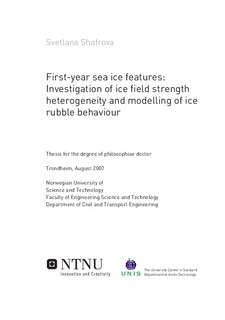| dc.contributor.author | Shafrova, Svetlana | nb_NO |
| dc.date.accessioned | 2014-12-19T11:26:10Z | |
| dc.date.available | 2014-12-19T11:26:10Z | |
| dc.date.created | 2008-02-18 | nb_NO |
| dc.date.issued | 2007 | nb_NO |
| dc.identifier | 123537 | nb_NO |
| dc.identifier.isbn | 978-82-471-3862-5 | nb_NO |
| dc.identifier.uri | http://hdl.handle.net/11250/231367 | |
| dc.description.abstract | For the nearest years the design load level for offshore structures in Arctic regions is likely to be controlled by first-year sea ice ridges and rubble fields if the icebergs are not present in the area. Drifting ridges may hit fixed or moored surface structure such as platforms or ships, or they may gouge the seabed endangering pipelines and wellheads. Both the temporal and spatial properties of the consolidated layer and the unconsolidated part (the ice rubble) of the ice ridge are important input into ridgeload models. A better understanding of the ice rubble behaviour will enable us to determine the ice-ridge load more accurately. This thesis deals with two separate but connected subjects, namely: the ice strength field heterogeneity of both first-year sea ice ridge and level ice and the mechanical behaviour of the ice rubble.
Field mechanical testing of first-year sea ice by uniaxial compression has been done in order to improve the knowledge of the ice fields strength heterogeneity. The inplane ice strength non-homogeneity of different ice fields on the landfast level ice in the Spitsbergen fjords were investigated. A typical ice strength variability was found to be about 20-40% for the vertical ice samples and 10-20% for the horizontal ones. The weak zones were found within the entire ice fields. It was established that the strength of the ice samples taken from a certain depth from the ice cover surface at the different locations of the same ice field varied by a factor of 3 to 4. Furthermore, two first-year sea ice ridges have been examined with respect to the 2D spatial strength distribution: one in the North-western Barents Sea and one in the Arctic Ocean nearby Spitsbergen. The ice ridges are characterized by high strength heterogeneity of 40-55%, where the ice strength varied more than 3 times along both vertical and horizontal directions.
Special Finite Difference program “Inhomogeneity” was used to study the influence of the ice strength heterogeneity on the ice loads. It was shown that the ice heterogeneity might be one of the reasons for the scale effect.
In order to investigate the nature of freeze bonds between the ice blocks, series of field and laboratory small scale tests were conducted with submerged ice blocks. The small scale field tests were carried out in Adventfjorden on Spitsbergen. An opening was made in the landfast level ice. The level ice was sawed into cubic blocks which then were submerged down into the water. Some of the ice blocks were cut in two parts and then frozen together in order to simulate the freeze bonds between the ice blocks. The other blocks were submerged without forming the adfreeze bond. In addition to that, laboratory tests with both artificial ice (fresh and sea water) and natural sea ice were conducted in the cold laboratories at the University Centre in Svalbard (UNIS). The temporal development of the freeze bonding strength and the local strength of the ice blocks in the ice rubble, their changes with block size, confinement and ice properties were studied. The average freeze bonding strength from the field tests was found as 32 ± 18 kPa after 48 hours of submerging. The corresponding freeze bonding strength from the laboratory tests was 67 ± 52 kPa for the natural sea ice and 274 ± 142 kPa for the artificial freshwater ice within 60 hours of testing. Moreover, the ratio of freeze bonding strength to the strength of the submerged ice was found in the range of 0.008 to 0.082 with an average around 0.03 after 48 hours of submerging in the field. The corresponding strength ratio varied from 0.14 to 0.38 for the artificial fresh water ice and from 0.015 to 0.40 for the sea ice within 60 hours of testing in the laboratory.
A pseudo-discrete continuum model has been developed to study the behaviour of the ice rubble and in particularly its initial failure mechanism that is associated with the breakage of the freeze bonding contacts (rubble skeleton). The model is a combination of discrete particle assembly generation and Finite Element analysis of this assembly. The model provides a possibility to simulate the contacts between the ice blocks. A parametric analysis simulating 2D direct shear tests shows that the pseudo-discrete continuum model is very sensitive to both strength and morphology of the freeze bonds between the ice blocks. An attempt to extend the model to study large deformations within the ice rubble (that is associated with rotation, rearrangement of the ice blocks and their breakage) was considered. | nb_NO |
| dc.language | eng | nb_NO |
| dc.publisher | Fakultet for ingeniørvitenskap og teknologi | nb_NO |
| dc.relation.ispartofseries | Doktoravhandlinger ved NTNU, 1503-8181; 2007:176 | nb_NO |
| dc.relation.haspart | Shafrova, Svetlana; Moslet, Per Olav. In-situ uniaxial compression tests of the level ice. Proceedings of the 25th International Conference on Offshore Mechanics ans Arctic Engineering (OMAE), 2006. | nb_NO |
| dc.relation.haspart | Shafrova, Svetlana; Moslet, Per Olav. In-situ uniaxial compression tests of the level ice.. Proceedings of the 25th International Conference on Offshore Mechanics and Arctic Engineering (OMAE), 2006. | nb_NO |
| dc.relation.haspart | Shafrova, A; Liferov, P; Shkhinek, K. Modelling ice rubble with pseudo-discrete continuum model. Proceedings of the 17th International Symposium on Ice (IAHR), 2004. | nb_NO |
| dc.title | First-year sea ice features. Investigation of ice field strength heterogeneity and modelling of ice rubble behaviour | nb_NO |
| dc.type | Doctoral thesis | nb_NO |
| dc.contributor.department | Norges teknisk-naturvitenskapelige universitet, Fakultet for ingeniørvitenskap og teknologi, Institutt for bygg, anlegg og transport | nb_NO |
